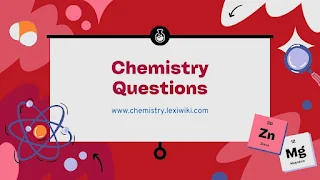Questions on Ideal Gas Law
Ideal Gas Law – Multiple Choice Questions
1. What is the formula for the Ideal Gas Law?
A) PV = mRT
B) PV = RT
C) PV = nRT
D) P/n = RT
E) PRT = Vn
2. In the Ideal Gas Law, the symbol n represents:
A) Number of atoms
B) Volume
C) Pressure
D) Number of moles
E) Temperature
3. Which of the following is not a variable in the Ideal Gas Law?
A) Pressure
B) Volume
C) Mass
D) Temperature
E) Number of moles
4. What are the SI units typically used in the Ideal Gas Law?
A) atm, L, mol, K
B) Pa, m³, mol, K
C) mmHg, L, g, °C
D) atm, cm³, mol, °C
E) psi, L, mol, °C
5. The ideal gas constant R has what value when pressure is in atm and volume in liters?
A) 0.0821 L·atm/mol·K
B) 8.31 J/mol·K
C) 1.00 L·atm/mol·K
D) 22.4 L/mol
E) 760 mmHg/mol·K
6. What happens to volume if temperature increases and pressure is constant?
A) Increases
B) Decreases
C) Remains the same
D) Doubles
E) Becomes zero
7. In the Ideal Gas Law, temperature must be measured in:
A) Celsius
B) Fahrenheit
C) Kelvin
D) Rankine
E) Centigrade
8. A gas occupies 10 L at 1 atm, 273 K. How many moles are present?
A) 0.5 mol
B) 1 mol
C) 0.446 mol
D) 2 mol
E) 1.22 mol
9. If the number of moles doubles while volume and temperature are constant, what happens to pressure?
A) Doubles
B) Halves
C) Increases slightly
D) Decreases slightly
E) Stays the same
10. Which gas condition violates the Ideal Gas Law assumptions?
A) Low pressure and high temperature
B) High pressure and low temperature
C) Standard pressure and temperature
D) Room temperature
E) Dry air
11. The Ideal Gas Law assumes gas molecules:
A) Are extremely large
B) Have no volume and no interaction
C) Always collide elastically
D) Only exist in vacuum
E) Are magnetic
12. A sample contains 1 mol of gas at STP. What is its volume?
A) 1.00 L
B) 22.4 L
C) 273 L
D) 0.0821 L
E) 100 L
13. Which of the following best describes the Ideal Gas Law?
A) A law that describes solids
B) A law relating volume to density
C) A combination of Boyle’s, Charles’s, and Avogadro’s laws
D) A formula for calculating molar mass
E) A version of Newton's Laws
14. If pressure and temperature are known, how can we find volume?
A) Use Boyle’s Law
B) Use Dalton’s Law
C) Use PV = nRT
D) Use Avogadro’s Law
E) Use P = m/V
15. Which gas is most likely to behave ideally?
A) Ammonia (NH₃)
B) Water vapor (H₂O)
C) Oxygen (O₂)
D) Carbon dioxide (CO₂)
E) Methanol (CH₃OH)
16. The Ideal Gas Law applies most accurately under what conditions?
A) Low temperature, high pressure
B) High temperature, low pressure
C) High temperature, high pressure
D) Low temperature, low pressure
E) Solid-state
17. If P = 2 atm, V = 5 L, n = 0.4 mol, and T = 300 K, what is R?
A) 0.0821
B) 0.150
C) 0.25
D) 0.1
E) 0.5
18. If the temperature of a gas is doubled, and the volume is constant, what happens to the pressure?
A) It doubles
B) It is halved
C) It stays the same
D) It becomes zero
E) It becomes 1 atm
19. Which component of the Ideal Gas Law accounts for the number of gas particles?
A) P
B) V
C) n
D) R
E) T
20. Which of these is not part of the Ideal Gas Law?
A) Molar mass
B) Temperature
C) Volume
D) Pressure
E) Number of moles
Answers with Explanations
1. C – The correct formula is PV = nRT, where P = pressure, V = volume, n = moles, R = gas constant, T = temperature.
2. D – n represents the number of moles of the gas.
3. C – Mass is not explicitly used in PV = nRT.
4. B – SI units: Pa, m³, mol, K; however, atm and L are common in chemistry.
5. A – R = 0.0821 L·atm/mol·K for common chemistry applications.
6. A – If pressure is constant and temperature increases, volume increases (Charles’s Law).
7. C – Temperature must be in Kelvin to avoid negative or zero values.
8. C – Using PV = nRT → n = PV/RT = (1×10)/(0.0821×273) ≈ 0.446 mol.
9. A – Doubling moles at constant V and T → pressure doubles.
10. B – High pressure and low temperature cause gases to deviate from ideal behavior.
11. B – Ideal gases are assumed to have no volume and no intermolecular forces.
12. B – At STP, 1 mol of ideal gas occupies 22.4 L.
13. C – The Ideal Gas Law combines Boyle’s, Charles’s, and Avogadro’s laws.
14. C – You can solve for V using PV = nRT.
15. C – O₂ is a non-polar, small molecule – behaves most ideally.
16. B – Ideal gas assumptions are best at high T and low P.
17. A – R = PV / nT = (2×5)/(0.4×300) = 10 / 120 ≈ 0.0821
18. A – At constant volume, pressure is directly proportional to temperature → pressure doubles.
19. C – n accounts for number of particles (in moles).
20. A – Molar mass is not in PV = nRT; it’s related to mass via n=m/Mn = m/Mn=m/M, but not part of the basic formula.
Dive into the groundbreaking science of neurotransmitters—your brain’s invisible architects—in Chemical Harmony: How Neurotransmitters Shape Our Lives (2025). This meticulously researched book reveals how serotonin, dopamine, GABA, and other brain chemicals silently orchestrate every aspect of your existence, from decision-making and relationships to mental health and emotional resilience.Click here to buy
Share Online!

